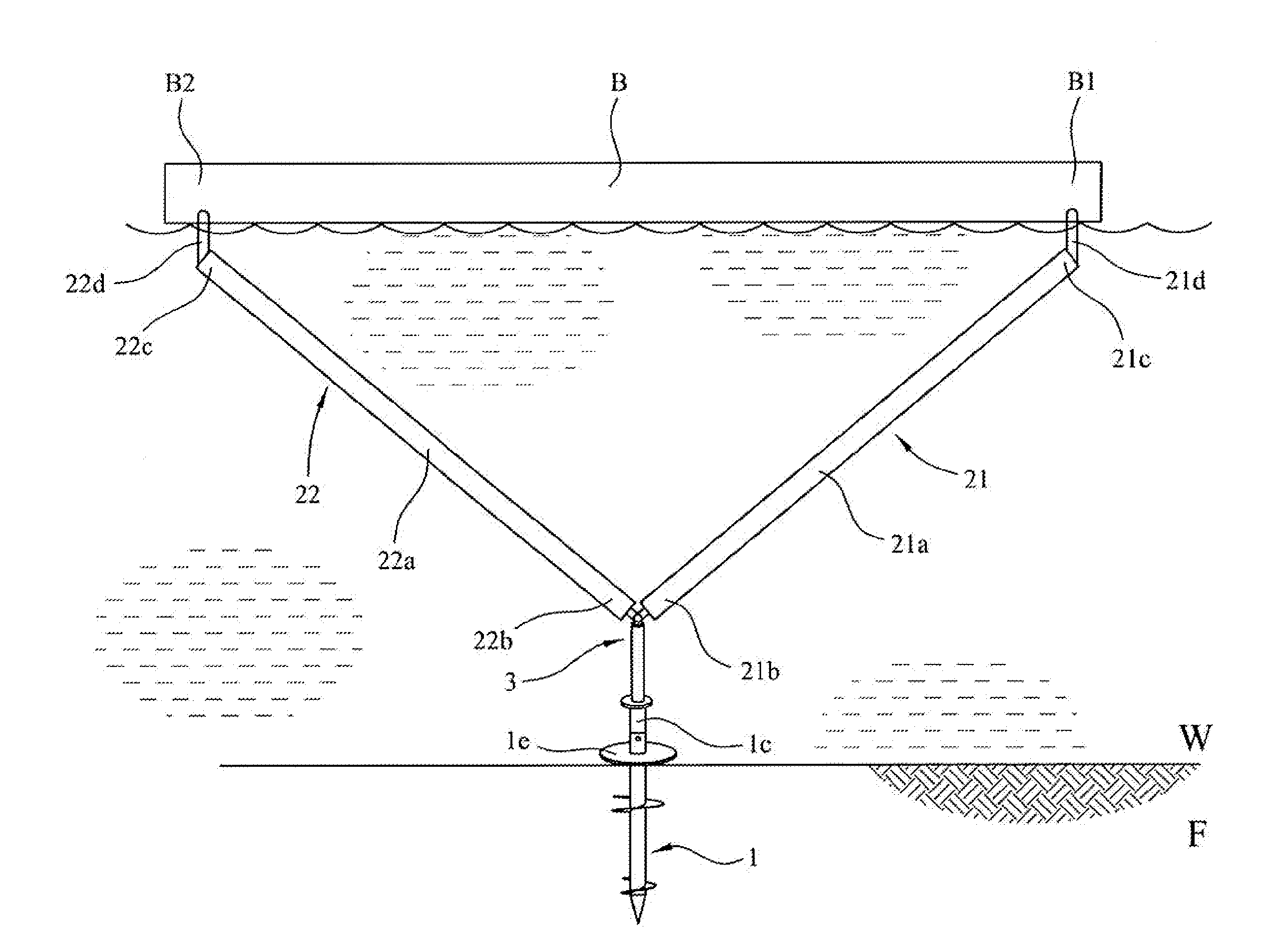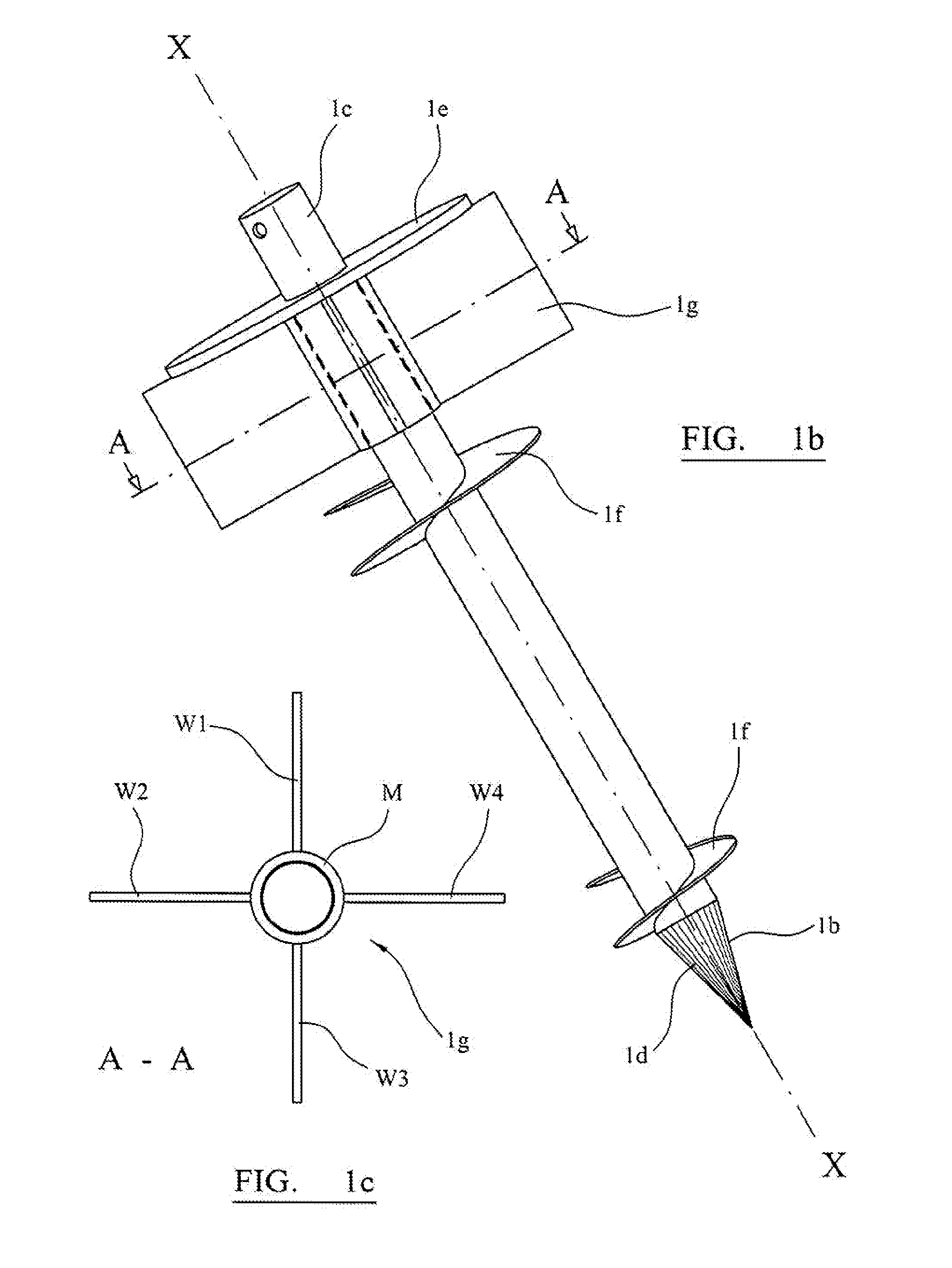Mooring device
a mooring device and mooring technology, applied in the direction of moorings, special-purpose vessels, vessel parts, etc., can solve the problems of affecting the aquatic environment, affecting the safety of passengers, etc., to achieve the effect of reducing the environmental impact on the aquatic environment, easy storage, transportation and installation, and reducing the environmental impa
- Summary
- Abstract
- Description
- Claims
- Application Information
AI Technical Summary
Benefits of technology
Problems solved by technology
Method used
Image
Examples
first embodiment
[0138]FIG. 1a depicts pile of the mooring device. The pile (1) comprises a shaft (1a) having a leading end (1b) and a trailing end (1c). The pile is formed from steel, it has a shaft length of approximately 2 m and a uniform shaft diameter of approximately 9 cm. A tip (1d) is formed at the leading end of the shaft. A stop plate (1e) is arranged approximately 1.5 m from the leading end of the shaft. Two helical plates (1f) with a maximum helix diameter of approximately 30 cm are mounted in spaced relation on the shaft between the tip and the stop plate. The longitudinal axis (XX) of the pile extends along the shaft from the leading end to the trailing end.
[0139]FIG. 1b depicts a pile of a second embodiment of the mooring device. As with the first embodiment, the pile comprises a shaft (1a) having a leading end (1b) and trailing end (1c). A tip (1d) is formed at the leading end of the shaft. A removable stop plate (1e) is arranged a predetermined distance from the leading end of the s...
second embodiment
[0159]FIG. 2b depicts a mooring device mounted in a body of water (F). The mooring device comprises a pile (1) as depicted in FIG. 1, a first arm (21), a second arm (22), a joint (3) and joint locking means (not shown). The mooring device moors an elongate floatable body (B) that floats on the surface of the water and extends between the first arm and the second arm. The pile is vertically embedded into the floor (F) to a depth where the stop plate (1e) abuts the surface of the floor and the trailing end (1c) protrudes above the floor. The first arm and second arm have an identical configuration. The first arm comprises a shaft (21a) having a first end (21b) and a second end (21c) and also a catch (21d) arranged at the second end for coupling a first end (B1) of an elongate floatable body. Likewise, the second arm comprises a shaft (22a) having a first end (22b) and second end (22c) and a catch (22d) arranged at the second end to couple the second end (B2) of the floatable body. The...
third embodiment
[0178]FIG. 5 depicts an exploded view of a joint (3) comprising a swivel hinge joint (32) and a clevis hinge joint (33). The swivel hinge joint (32) comprises a shaft portion (32a) that is indirectly coupled to the arm (2) and a recess portion (32b) that is directly coupled the trailing end of the pile (1c) whereby the shaft portion is rotatably mounted in the recess portion to allow for rotation of the arm around the shaft axis. The clevis hinge joint (33) comprises a tang portion (33a) that is directly coupled to the first end of the arm (2a) and a fork portion (33b) that is indirectly coupled to the pile, whereby the tang portion is rotatably coupled to the fork portion by a clevis pin (33c) to allow for rotation of the arm around the clevis pin axis which is perpendicular to the longitudinal axis of the pile. Hence, if the pile is vertically embedded in the floor, the swivel hinge joint allows the arm to rotate with respect to the pile around a vertical axis (in a horizontal pla...
PUM
 Login to View More
Login to View More Abstract
Description
Claims
Application Information
 Login to View More
Login to View More - R&D
- Intellectual Property
- Life Sciences
- Materials
- Tech Scout
- Unparalleled Data Quality
- Higher Quality Content
- 60% Fewer Hallucinations
Browse by: Latest US Patents, China's latest patents, Technical Efficacy Thesaurus, Application Domain, Technology Topic, Popular Technical Reports.
© 2025 PatSnap. All rights reserved.Legal|Privacy policy|Modern Slavery Act Transparency Statement|Sitemap|About US| Contact US: help@patsnap.com



